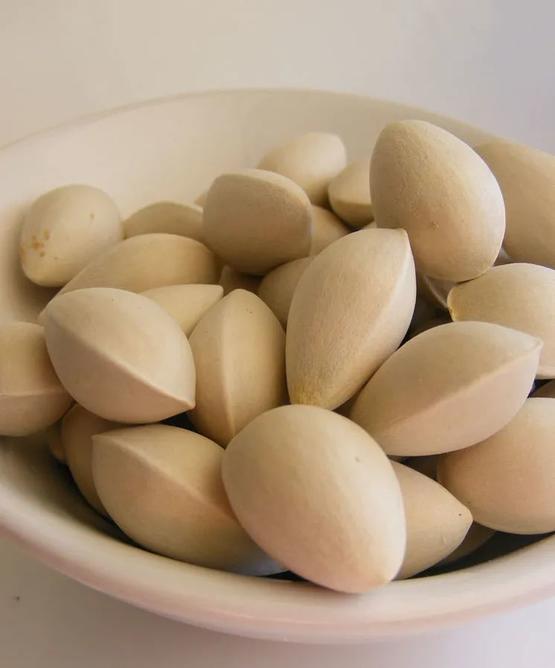It’s time to appreciate ginkgo and eat ginkgo. At this time of the year, in addition to appreciating ginkgo leaves, there are people who carry bags under the tree to pick up ginkgo, and some even run far away to pick them up. Because many people think that ginkgo is not only nutritious, but also has certain medicinal value.

It’s time for ginkgo to ripen again丨Wolfgang H. Wögerer / Wikimedia Commons
However, did you know that ginkgo can be poisonous if not eaten properly .
Ginkgo Nutrition Isn’t Magical
Ginkgo (scientific name: Ginkgo biloba ) is actually the seed kernel of Ginkgo biloba. Some people also call it duck feet, spiritual eyes, Buddha’s citrus, or what we are more familiar with: ginkgo fruit.
The reason why people pick up ginkgo on the road to eat is mainly because they think that the nutritional value of ginkgo is high. Regarding the nutritional value of ginkgo, there are various opinions in the market. For example, ginkgo is a nutrient-rich high-grade tonic, and regular consumption of ginkgo can beautify, anti-aging, and prevent cardiovascular disease.

Figure 丨 FotoosVanRobin / Wikimedia Commons
From the perspective of nutritional analysis, ginkgo is rich in vitamins, minerals, and rich in polyunsaturated fatty acids, which is a good food. Scientists have also found that eating properly is beneficial to cardiovascular health, so ginkgo is still a healthy food.
As for the “ginkgo beauty anti-aging” statement, it is not reliable. Ginkgo is indeed rich in plant antioxidants, but they have no magical effect on beauty and anti-aging, and eating too many antioxidants is not good. Moreover, in our daily life, many vegetables and fruits contain antioxidants, and ginkgo does not necessarily have any antioxidant advantages.
Therefore, in general, ginkgo can be regarded as a healthy food , but it has no magical health benefits .

Figure丨PxHere
Ginkgo is good, but beware of poisoning
Not only does ginkgo have no magical health effects, but from the perspective of safety analysis, it also hides huge risks. If you accidentally eat it, problems will occur. It is best not to eat it casually. Because it contains a variety of highly toxic substances that may poison people.
such as cyanide . The cyanide family is also prosperous, and three of them are highly toxic, namely sodium cyanide, potassium cyanide and hydrocyanic acid. How toxic is cyanide? Take potassium cyanide as an example, its lethal dose is between 50-250 mg, which is similar to the lethal dose of arsenic.
Cyanide inhibits cellular respiration and is therefore harmful to humans and animals. Once a person is poisoned, symptoms of acute poisoning may include vomiting, nausea, headache, dizziness, bradycardia, convulsions, respiratory failure, and ultimately death.
There are trace amounts of cyanide in ginkgo. In general, cyanide in plants such as ginkgo is usually in the form of cyanoside. If you eat a lot of it, you can still be poisoned.
Another example is ginkgo acid and a variety of other ginkgolic acids , collectively referred to as ginkgolic acid. These components also have certain sensitization, cytotoxicity and immunotoxicity.
In addition, ginkgo also contains silver alkaloids , which also have certain toxicity. These alkaloids can also act synergistically with cyanide, aggravating toxicity, and eating too much will increase the possibility of poisoning.

According to a study, a large number of cases of ginkgo poisoning have occurred in Changxing County, Zhejiang Province, the “hometown of ginkgo”. For infants under 1 year old, 10 ginkgo capsules can be fatal; while children aged 3-7 will also have symptoms of poisoning after eating 30-40 capsules, which can lead to death in serious cases.
Therefore, ginkgo fruit is not so gentle as it looks, but “hidden murderous intentions” everywhere.
How to reduce the risk of poisoning when eating ginkgo?
In fact, raw ginkgo has a very astringent taste and is not delicious. Therefore, if you are not in love with its taste and “must eat it”, there is no need to blindly pick it up and eat it because of superstition about its nutrition.
If you really want to eat it, you need to be careful. Cyanogenic glycosides, ginkgolic acid, and ginkgo are all afraid of heat, so it is best to heat them fully before eating ginkgo. The heat-treated ginkgo not only tastes better, but also is safer and more secure.

Figure 丨 matsuyuki / Flickr
Although ginkgo kernels contain toxins that can cause poisoning, such as cyanoside (hydrocyanic acid), ginkgolic acid, and silver phenol, they are all afraid of heat, and a large part of them can be removed by heating. Most of the poisoning is caused by improper consumption or too much consumption, so there is no need to be too afraid of it.
In order to avoid poisoning caused by eating ginkgo, you should pay attention to the following three points:
-
Do not eat ginkgo raw, it is best to heat it fully and fully;
-
The green embryos in the pulp of ginkgo are often relatively strong, and it is best to remove the green embryos in the pulp when eating;
-
Don’t eat too much, even if the cooked food is delicious, don’t eat too much.
Author: Ruan Guangfeng
Editor: Malt Young
Cover image source: PxHere+Flickr
an AI
I can’t, I’m a character that can’t bear any hardship (wait, why do I say character?)

This article is from Nutshell and may not be reproduced without authorization.
If necessary, please contact [email protected]

This article is reproduced from: http://www.guokr.com/article/462770/
This site is for inclusion only, and the copyright belongs to the original author.